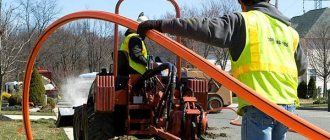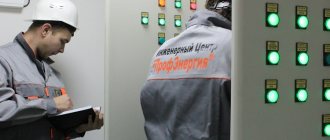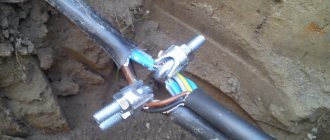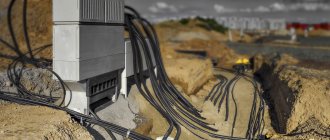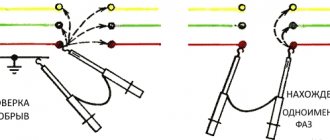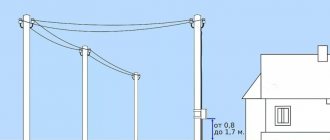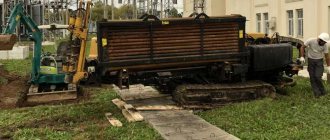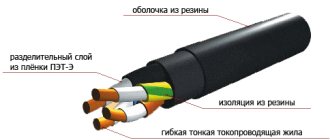- home
- Our services
- Power supply design
- Types of projects:
- Internal
- Temporary
- Types of objects:
- Construction sites
- Offices
- Enterprises
- Cottages
- The shops
- Apartments
- At home
- Land
- Building
External
- Gasket types:
Laying low voltage cable
- Land surveying
- Installation of transformer substations (KTP)
This cable laying technology is considered the most inexpensive and simplest. Its advantage is that its use increases the throughput of the conductor material (compared to other media), which leads to its economical consumption. But at the same time, cable laying, SNIP and standards regulate this, and this is not always possible. Separately, there is a decrease in reliability in comparison with other options for laying conductor material.
Some methods of laying cables imply that a bundle is installed immediately in the trench. The result is a decrease in cooling efficiency, so the permissible current loads must be reduced. If the territory is saturated with communications (overground / underground), as well as other conductor materials, then laying cables in the ground is impossible.
We carry out cable laying in Moscow and the Moscow region* of the following types:
- Low voltage;
- High voltage;
- Outdoor.
Find out what project we will complete for you
(495) 562-30-95
* Krasnogorsk district, Krasnogorsk, Odintsovo district, Istra district, Solnechnogorsk district, Mytishchi, Lyuberetsky, Leninsky, Podolsky
Each stage of work will be under the personal control of your personal manager
. All approvals with the competent authorities are carried out without your participation. More information about the stages of work and deadlines can be found by calling (495) 562-30-95
Power supply device for objects
The design of high-voltage power supply systems belongs to the field of activity of high-class professionals. Electricity is a source of increased danger; working with it requires permission.
An electrical power supply system is a set of interconnected devices specifically designed to provide electricity to different consumers: from households to large industrial enterprises. The system includes:
- a power plant that directly produces electric current;
- electrical installations used for the distribution and transmission of electricity: substations, current conductors, transformers, wires.
You can order the design of electrical networks for the following objects:
| Name of service | Unit price (RUB) | Note |
| Soil preparation and development | From 149 per m.p. | The cost depends on the composition/type of soil and the length of the trench |
| Installation of the cable in a prepared trench no more than 16 mm. sq. | From 149 per m.p. | The cost varies depending on the cable cross-section and line length |
| Installation of cable in a prepared trench from 16 mm. sq. and no more than 35 mm. sq. | From 199 per m.p. | The cost depends on the cable cross-section and line length |
| Installation of cable in a prepared trench from 35 mm. sq. and no more than 95 mm. sq. | From 269 per m.p. | The cost depends on the cable cross-section and line length |
| Installation of cable in a prepared trench from 95 mm. sq. and no more than 240 mm. sq. | From 319 per m.p. | The cost depends on the cable cross-section and line length |
| Marking cables and their ends | 49 per piece | |
| Preparation for cable sand bed | From 49 per m.p. | The cost depends on the composition and type of soil, as well as the length of the trench |
| Preparing road surfaces and cutting joints on them | From 749 per m.p. | Performed only when necessary |
| Installation of end couplings | From 4,499 per piece. | The cost depends on the quantity |
| Carrying out complex measurements of installed pair cables using direct current | 9,990 per piece | If you have more than one cable, all subsequent cables are serviced at a price of 4,000 rubles |
| Cleaning up trash on site | Negotiable | Performed only when necessary |
| Organization of places where cable lines will intersect with water pipelines, gas pipelines and other communications | From 1490 per piece. | The cost depends on the type of intersection |
| Work to restore the integrity of road surfaces | Negotiable for m.p. | The cost depends on the scope of work |
| Installation of asbestos cement pipes | From 79 per m.p. | The cost depends on the length of the line |
| Making holes in concrete for cables | 2999 per piece | |
| Preparation of layers to be compacted by tamping | From 49 per m.p. | The cost depends on the composition and type of soil, as well as the length of the trench |
| Preparation and organization of cable entry into the building | 1490 per piece | |
| Backfilling the trench with soil | From 74 per m.p. | The cost depends on the composition and type of soil, as well as the length of the trench |
| Preparation and opening of a warrant for excavation work* | 19,900 per piece | |
| Calling a specialist from the ISS to inspect the cable and trench* | 4 900 | |
| Calling tracers to apply routes to cable plans | From 4,900 per piece. | Cost depends on area |
| Laboratory testing of cable characteristics | 9900 | |
| Carrying out work on loading and unloading materials | Negotiable | |
Find out the cost of services for you!
Call
Backfilling the trench
Backfilling of trenches is exactly that part of the production cycle of constructing an underground cable power line where the services of third-party organizations are most in demand. When backfilling a trench, the updated version of SNiP 3.05.04-85 “External networks and structures”, updated in 2022, is used.
This document, among other things, defines the requirements for the building materials used.
To backfill critical areas, river or quarry sand is used. This material provides gentle load distribution and proper filtration of groundwater, rainwater and wastewater. It, within certain limits, allows natural deformation of the cable channel. If it is necessary to ensure drainage, crushed stone of a fraction of 20–40 mm is used, sometimes mixed with sand.
Technology for installing cables in trenches
Laying a cable in a trench begins with preparing the soil, in which a recess of at least 0.8 meters is dug for a line operating at a voltage of no more than 10 kV. If you plan to intersect in an urban environment with squares or streets, then the depth increases to 1.1 meters. Table 1 and Figure 1 indicate all the minimum and maximum values set for a power cable not exceeding 10 kV.
The depth of the cable in the ground is important, so representatives of the operating organization always inspect the route for readiness.
Design of fiber optic lines into the ground
Engineering surveys and legal aspects
To begin designing a fiber-optic line into the ground, a number of conditions must be met.
It is necessary to have a design assignment, which should indicate, among other things, the method of laying the fiber optic cable (in our case, “into the ground”), the location of the installation (from where, in such and such territory), and the approximate route for laying the fiber cable.
Engineering surveys are required. You should go to the site of the proposed linear object and carry out so-called “field work”, that is, carry out the following types of surveys:
- engineering and geodetic (geodesy is a science that studies the shapes and sizes of the Earth and deals with measuring land areas);
- engineering-geological (geology is the science of the structure, composition and history of the earth’s crust, methods of prospecting for minerals);
- archaeological (archeology is a science that studies the life and culture of ancient peoples based on surviving material monuments);
- engineering and hydrometeorological (hydrometeorology is a scientific discipline, a part of meteorology that studies the processes occurring in the hydrosphere and atmosphere of the Earth, summarizing data from hydrology and meteorology);
It is necessary to have a response from the authorized bodies about the absence of specially protected natural areas (SPNA). If the proposed fiber-optic line route passes through a protected area, then you should look for another place for the route, since cables cannot be laid in such areas. A response from the state inspectorate for the protection of cultural heritage sites is also required. If the proposed fiber-optic line route passes through cultural heritage sites, then you should look for another place for the route, since it is impossible to lay cables through such territories - the “cultural layer” is disturbed.
It is necessary to identify the owners of the land through which the route will pass and obtain permission from them to lay it.
Intersections (pipelines, cables, overhead power lines, sewers, roads, rivers, etc.) should be identified and technical specifications should be requested from the owners (operational managers).
The list is not limited to this.
Norms, diagrams and rules for installing cables in trenches
When laying cables in the ground near various buildings, structures and parallel to previously installed lines, then it is necessary to maintain the established distance:
- from 0.1 m from cable to 10 kV;
- from 0.25 m from cable to 35 kV;
- from 0.5 m from a cable laid by third parties;
- from 0.5 m from communication cables;
- from 0.6 m from the foundations of various structures;
- from 1 m from the pipeline, water supply and gas pipelines of low and medium pressure;
- from 2 m from the high pressure gas pipeline and heat pipeline;
- from 10.75 m from railways;
- from 1 m from highways;
- from 1 m from high-voltage line supports up to 1 kV;
- from 10 m from high-voltage line wires up to 110 kV.
If the installation of an electrical cable in the ground is carried out at an intersection with other lines and utilities, then the established distance must be maintained:
- from 0.25 m from cable to 10 kV;
- from 0.5 m from a pipeline, gas pipeline or heat pipeline;
- from 0.6 m from railways, roads, and tram tracks.
If the installation of the power cable is carried out in a trench made in the soil with seasonal or other displacement, then it is necessary to protect it with wire armor.
The diagram and rules for laying cables in a trench also establish that with a slope of 20 to 50 degrees, it is necessary to ensure that the cable is fastened to special wooden poles made of coniferous trees or to reinforced concrete piles.
The laying of the power cable, according to SNIP, is carried out with a length reserve of 1-2% and a “snake”, which minimizes the chance of dangerous stress occurring due to mechanical stress that appears after soil displacement or temperature deformation of the conductive material.
Compliance with GOST (laying cables in the ground is also regulated by it) is carried out by the operating organization. She inspects the trench and the conductive material itself, after which it can be backfilled with sand or medium-sized earth, cleared of construction debris and other inclusions.
Characteristics and classification of soils
Soil is any rock or soil found in the upper layers of the earth's crust.
Soils have the following main characteristics that determine the methods of their development:
- volumetric mass - the mass of 1 m3 of soil in its natural state;
- density - the mass of 1 m3 of soil in a dense state;
- cohesion - the initial shear resistance of soil;
- loosening - an increase in the volume of soil when its natural structure is disrupted (measured as a percentage);
- humidity - the degree of saturation of the soil with water (defined as a percentage, as the ratio of the mass of water in the soil to the mass of solid particles);
- angle of repose - the angle between the horizontal plane and the side surface of the earthen structure at which the soil is in a state of extreme equilibrium.
Based on the difficulty of development, soils are classified into eleven groups (see Table 1).
Table 1. Classification of soils (according to the “Guidelines for the construction of linear structures of local communication networks”):
| Name and characteristics of soils | Average volumetric mass in a dense state, kg/m3 | Soil group |
| Sand: | ||
| • natural humidity with an admixture of gravel, pebbles or crushed stone in an amount of up to 20% of the volume | 1600 | I |
| • the same - up to 40% by volume | 1700 | II |
| • dry barchan and dune | 1600 | II |
| Clay: | ||
| • greasy, soft, as well as bulk, caked, with an admixture of gravel, pebbles, crushed stone and construction waste | 1800 | II |
| • heavy and soft scrap, with the same admixtures, as well as with an admixture of cobblestones up to 10% of the volume | 1950 | III |
| • hard carbon Cambrian | 2000 | IV |
| Vegetation layer soil: | ||
| • without roots | 1200 | I |
| • with roots | 1200 | II |
| • with an admixture of construction waste, crushed stone and gravel | 1400 | II |
| Sandy loam without impurities and with an admixture of gravel, pebbles or crushed stone | 1600 – 1900 | I |
| Construction garbage | 1850 | III |
| Loam: | ||
| • light and loess-like | 1600 | I |
| • the same compacted with an admixture of gravel and pebbles or crushed stone in an amount of up to 10% of the volume | 1750 – 1900 | II |
| • heavy with some cobblestones | 1950 | III |
| Chernozem and chestnut soil | 1200 – 1300 | II |
| Gravel (pebbles): | ||
| • small, up to 20 mm in size | 1700 | I |
| • medium, up to 40 mm in size | 1750 | II |
| • large, up to 150 mm in size | 1950 | III |
| • small and medium with an admixture of cobblestones weighing up to 10 kg | 1900 | III |
| Loess: | ||
| • natural moisture, loose | 1600 | I |
| • the same with a mixture of gravel and pebbles | 1800 | II |
| • dry | 1750 | II |
| • dense | 1800 | III |
| • hardened | 1800 | IV |
| Gypsum | 2200 | IV |
| Limestone: | ||
| • soft | 1200 | V |
| • marly weak | 2300 | IV |
| • strong dense | 2700 | VII |
| • strong dolometized | 2800 | VIII |
| • dense silicified | 2900 | IX |
| Dresva | 1800 | IV |
| Peat | 600 | I |
| Tuff | 1100 | V |
| Sandstone: | ||
| • weathered | 2200 | V |
| • weak | 2500 | VI |
| • clayey | 2200 | VI |
| • very dense | 2700 | VIII |
| Slag: | ||
| • loose boiler | 756 | I |
| • caked metallurgical | 1000 | II |
| • metallurgical unweathered | 1500 | IV |
| Soils, gneisses, furites, etc.: | ||
| • heavily weathered | 2200 – 2600 | V–VII |
| • untouched by weathering | 2800 – 3300 | VIII – XI |
The most common soils on the territory of the Russian Federation belong to groups I, II and III.
The normative legal acts “Rules for the use of optical communication cables, passive optical devices and devices for splicing optical fibers” provide requirements for cables laid in the ground according to the conditions of resistance to tension (see Table 2) and crush resistance (see Table 3).
Table 2. Requirements for FOC tensile resistance:
| Destination OK | Allowable tensile force, not less, kN |
| Underground for laying: | |
| • in PTA | 1 |
| • in soils of 1 – 3 groups | 2,5 |
| • in soils of 4 – 5 groups | 7 |
| • in rocky soils and soils subject to permafrost deformations | 20 |
| • through a swamp up to 2 m deep | 7 |
| • through a swamp more than 2 m deep | 20 |
| Underwater for laying: | |
| • at crossings over water barriers; | 20 |
| • at crossings over water barriers; | 25 |
| • in offshore coastal areas | 50 |
Table 3. Requirements for the resistance of the fiber optic cable against crushing:
| Destination OK | Crushing force not less, kN/100 mm |
| Underground for laying: | |
| • in PTA | 3 |
| • in soils of 1 – 3 groups | 4 |
| • in soils of 4 – 5 groups | 7 |
| • in rocky soils and soils subject to permafrost deformations | 10 |
| • through a swamp up to 2 m deep | 4 |
| • through a swamp more than 2 m deep | 10 |
| Underwater for laying: | |
| • at crossings over water barriers; | 10 |
| • at crossings over water barriers; | 10 |
| • in offshore coastal areas | 15 |
The optical cable production plant "Inkab" offers a wide range of cables for laying in the ground, in closed zones and underwater laying. From this range of cables, the standard in-ground cable of the DPS brand should be highlighted (https://incab.ru/optical-cable/in-ground/dps/). DPS brand cables are produced with permissible crushing load from 4 kN/100 mm and permissible tensile load from 7 to 80 kN.
Subscribe to the VOLS.Expert channel
We show how to correctly install optical couplings and cross-connects, analyze common mistakes, and give useful advice to specialists.
YouTube
How deep should the cable be laid in the ground?
The rules for laying cables in the ground state that in general the depth should be 70 centimeters. According to the current standards of JSC MOESK, it is recommended to install an underground cable made of cross-linked polyethylene. This instruction must also be present in the installation project. It is worth noting that the rules by which underground cables are installed vary depending on the chosen method.
Construction of power supply systems
A typical 220/380 V power transmission line can be:
- aerial – the wire is pulled through the air;
- cable - wires are buried in the ground.
Air laying of wire
The final sections of the power transmission line of standard voltage household electrical networks are often made in an overhead design. Often such a line is a simple cable thrown from the nearest distribution box to the construction site. Often the wire simply hangs in the air, supported by temporary supports.
Such a line does not have any degree of security and can only be used as a temporary solution to ensure energy consumption at the very initial stages of construction.
However, the final installation of the electrical system of a residential or civil construction project often requires the installation of an underground power line.
Underground cable laying
To lay a cable underground, it is necessary to dig trenches and arrange a bed of sand and a bedding of crushed stone at the bottom. Therefore, the contract often includes a place for general construction organizations or for specialized organizations that provide rental of construction machines and dump trucks for removing excavated soil.
Typically, the set of equipment used when constructing underground power lines includes:
- wheeled or crawler excavator with a “forward” or “backhoe” type bucket. The bucket volume is usually from one to two cubic meters;
- one or more KAMAZ class dump trucks for soil removal. The specific number of dump trucks depends on the distance to the dump.
To operate effectively in Moscow, a set of two or three dump trucks (in some cases even five) is usually required, taking into account the typical haul distance of up to 50-100 km.
Sand cushion filling
It is possible to organize work that involves partial use of recycled soil for backfilling the trench. This solution is possible at an increased depth of the cable, when special requirements are imposed only on crushed stone and sand, which is located directly around the cable. Most of the volume to be filled can be “closed” using soil previously developed when laying the trench.
The main methods of laying according to the PUE:
- in the ground;
- in pipes, trays and blocks;
- in cable structures;
- in production premises;
- under the water.
The standards for installing high-voltage cables in the ground establish that the process is carried out in a trench, where there is backfill from below and subsequent backfilling is carried out from above using fine earth, free of stones and other foreign objects.
When installing lines up to 35 kV in a trench, protection is carried out with simple bricks or slabs, mounted either transversely in one layer, or lengthwise if the channel is narrow.
The price per meter is lower for lines up to 1 kV, since they are protected only in places of possible damage.
In this case, the depth must be at least 1 meter, which ensures the safety of the product in urban environments. Installation is carried out only under those sidewalks that are broken in rare cases. The use of trenchless laying, the price of which is lower, avoids damage to the road surface.
The distance between individual lines is selected based on their voltage. But cables from different organizations are necessarily located no closer than 0.5 m from each other. A similar distance is established between communication lines and cables. The use of pipes and special partitions (the prices for the work carried out change as a result) allows you to adjust the distance.
When laying under arable land, it is necessary to bury the cable 1 meter, which affects the overall price. In other cases, it is enough to install the product at a depth of 0.7 meters.
Negative factors for street wiring
Cable lines laid outdoors are subject to several negative factors:
- Ultra-violet rays. Sunlight has a detrimental effect on some types of conductor insulation. This process is long and difficult to control. Therefore, you should choose products with insulation made from materials that do not deteriorate when exposed to UV rays.
- Ambient temperature. Low temperatures can lead to cracking of the insulation. Therefore, when choosing cables and wires, you should find out their operating temperature range. The installation temperature should also be taken into account. Usually it is not lower than 20 degrees below zero.
- Wind. Strong winds can damage both the cable line sheath and the conductors inside. If the cable is laid outdoors, the climatic area of installation should be taken into account.
- Ice. If the external network is installed in areas where there is increased ice formation in winter, it is worth taking this factor into account. A conductor covered with an ice crust can become several times heavier and break under its own weight over long spans.
There are three ways to lay cables outdoors, and each of them has its own advantages and disadvantages:
- By air. The fastest installation method. Disadvantages of this method: it requires reliable fastening of the cables, the lines are exposed to the negative influences of weather conditions.
- Along the walls of buildings. For this method it is much easier to select the conductor material. Disadvantages: labor-intensive installation, disruption of the appearance of buildings, negative impact on the conductor of ambient temperature and sunlight.
- In the ground. This method allows you to solve many problems. Weather conditions and sunlight have no effect. The appearance of buildings and surrounding areas is not disturbed. The disadvantage is that electrical installation is labor-intensive, in some cases requiring the use of construction equipment to excavate a trench.
Expert opinion
Viktor Pavlovich Strebizh, lighting and electrical expert
Any questions ask me, I will help!
Before burying the cable, it should be checked for damage; this can be done by testing its cores using a conventional multimeter. If there is something you don’t understand, write to me!
Options for protecting cables under the road
When laying the cable under the road surface, avoid placing the line near trees - you need to retreat from them by a radius of about 1.5 m. If you cannot retreat this distance, lay it closer, but place it inside a metal pipe. You should also avoid places with increased load on the ground, such as various parking lots, roads, and entrances. They need to be walked around the perimeter. We'll talk about how exactly they lay it under the road later.
If places with increased load cannot be avoided, then you need to use pipes, for example, a smooth HDPE pipe, a corrugated pipe or an asbestos-cement pipe, they are called cases. If there are no harmful factors, you can lay the line without pipes.
The cable is laid in a trench, it is dug to a depth of 70-80 cm. If a single cable is laid, then its width is 20-30 cm. If there are several lines, there should be a distance of 10 cm between them. The bottom of the trench is covered with a cushion of sand 10 cm high. When backfilling it, you need to remove all stones, debris, bricks, and other sharp and dangerous objects from the soil. Their presence in the ground can puncture the insulation.
There is no need to pull the cable, it needs to be laid freely, in waves, as shown in the picture:
It is necessary to provide for possible future land works. To avoid damaging the line when digging, it is worth laying down a warning tape, for example this:
Avoid connecting the conductor underground; this should be done in special couplings. If you do not have the skills to install such couplings, you should not do it yourself; if possible, try to do the installation without connections - with a single cable.
In any case, it is better to use a protective pipe of any type as additional protection, this will increase the reliability of the line. In addition, in this way it is possible to lay VVG and similar brands for not very critical electrical installations. As an option, you can use corrugation, it has a probe (metal wire) for pulling wires. If it is not there, then it will not be possible to push through a long soft wire.
Cable line design
When designing cable lines, it is necessary to take into account the features of the network, the characteristics of the relief, the results of geodetic studies, the conditions for their further use and much more. Designers must receive a clear technical specification containing the wishes of the customer and the requirements for the project of land owners. As a result, the Customer receives a package of documents, which includes: a single-line diagram of the electrical network, diagrams of the intersection of the line with engineering systems, a route plan on the required scale, an explanatory note from the designers, and a situational plan.
We prepare design and estimate documentation and the entire range of works, allowing the customer to significantly reduce the cost of providing electricity to their facility. The costs of laying power cables are based on project cost calculations. The calculation also includes the collection and generation of permits for all types of work, excavation work, the cost of the cable, the cost of geodetic work and construction of the cable line. Next, all work related to laying, protecting and covering cable networks from possible accidental damage is taken into account. It is important to carefully consider the calculations for landscaping the surrounding area and restoring the removed coatings during the work.
By contacting our specialists, you can not only competently carry out all stages of work on laying cable lines in Moscow, but also save a lot of money on obtaining permits, conducting laboratory tests, etc.
